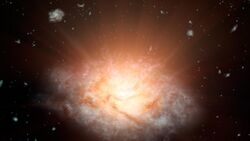Astronomy:WISE J224607.57-052635.0
Coordinates: ![]() 22h 46m 07.57s, −05° 26′ 35.0″
22h 46m 07.57s, −05° 26′ 35.0″
| WISE J224607.57-052635.0 | |
|---|---|
 WISE J224607.57-052635.0 is the most luminous galaxy in the Universe. (artist's impression) | |
| Observation data | |
| Constellation | Aquarius |
| Right ascension | 22h 46m 07.57s |
| Declination | −05° 26′ 35.0″ |
| Redshift | 4.593[1] |
| Distance | 12.5×109 light-years (3.8×109 parsecs)[2] |
| Characteristics | |
| Type | Spiral |
| Other designations | |
| WISE 2246-0526 | |
WISE J224607.57-052635.0 is an Extremely Luminous Infrared Galaxy (ELIRG) which, in 2015, was announced as the most luminous galaxy in the Universe. The brightness is 300 trillion times that of the Sun (349×1012L☉[1]). The light is generated by a quasar 10 billion times the mass of the Sun. The light emitted by the quasar's supermassive black hole is converted to infrared rays by the galaxy's dust. The galaxy releases 10,000 times more energy than the Milky Way galaxy, although WISE J224607.57-052635.0 is smaller than the Milky Way galaxy. WISE J224607.57-052635.0 has a light travel distance of 12.5 billion light-years from it to Earth. The galaxy was discovered by using the Wide-field Infrared Survey Explorer.[1][2][3][4][5]
See also
- Luminous infrared galaxy
- SDSS J0100+2802, hyperluminous quasar
- W2246-0526 (song), an EP by Belarussian Death Metal band Eximperituserqethhzebibšiptugakkathšulweliarzaxułum
References
- ↑ 1.0 1.1 1.2 Tsai, Chao-Wei (22 May 2015). "The Most Luminous Galaxies Discovered by WISE". The Astrophysical Journal 805 (2): 90. doi:10.1088/0004-637X/805/2/90. Bibcode: 2015ApJ...805...90T.
- ↑ 2.0 2.1 Staff (21 May 2015). "WISE spacecraft discovers most luminous galaxy in universe". http://phys.org/news/2015-05-wise-spacecraft-luminous-galaxy-universe.html. Retrieved 22 May 2015.
- ↑ Staff (21 May 2015). "PIA19339: Dusty 'Sunrise' at Core of Galaxy (Artist's Concept)". NASA. http://photojournal.jpl.nasa.gov/catalog/PIA19339. Retrieved 21 May 2015.
- ↑ Chou, Felicia; Clavin, Whitney (21 May 2015). "NASA's WISE Spacecraft Discovers Most Luminous Galaxy in Universe". http://www.nasa.gov/press-release/nasas-wise-spacecraft-discovers-most-luminous-galaxy-in-universe. Retrieved 25 May 2015.
- ↑ Lemonick, Michael D. (26 May 2015). "Brightest Galaxy Yet Shines With Light of 300 Trillion Suns". National Geographic News. http://news.nationalgeographic.com/2015/05/150526-astronomy-brightest-galaxy-quasar-universe. Retrieved 27 May 2015.
External links

